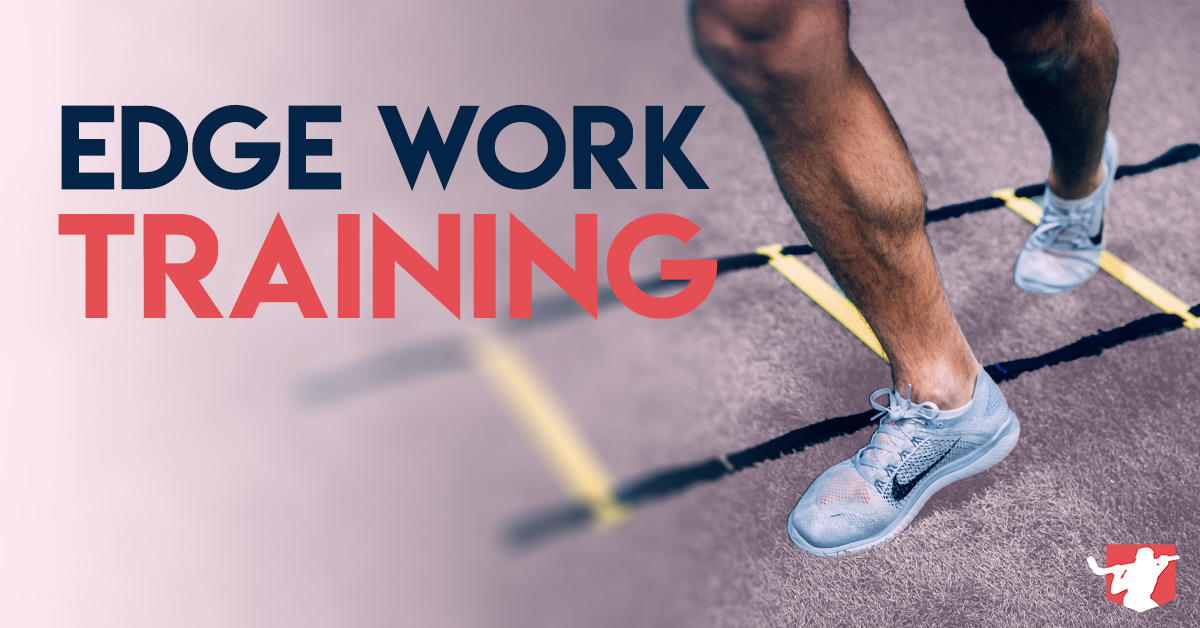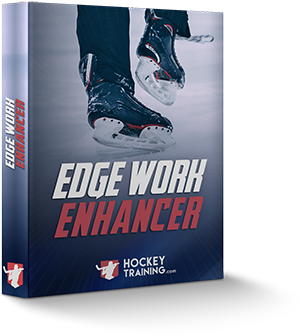*Before checking out this article, I highly recommend bookmarking our brand new Hockey Speed Kit and 30-Day Breakaway Speed System here so you can get instant access to the best hockey-specific equipment and programming solution to improve your all-around edge work and skating speed out on the ice*
In this article, I’m going to teach you the importance of ankle stability and mobility for hockey players and provide you with exercises that will enhance edge work out on the ice.
- Why ankle stability and mobility is important for edge work
- How a lack of ankle mobility can lead to hockey injuries
- How hockey players can test ankle mobility
- Ankle exercises to improve your edge work
In hockey training, much emphasis is placed on elements such as explosive training, agility drills, and compound strength movements; but, if you don’t have good foot mechanics you won’t be getting nearly as much out of these drills as you otherwise would have.
I want you to think about high-performance race cars for a moment.
Do you ever think the driver and crew just throw any old tires on there?
Or do you think that they respect the fact that the tires bear the load of the vehicle, need to be able to generate enough friction with the road to prevent slippage, and need to have a strong enough lifespan to last a race?
If you compare the tires from a race car to a transport truck they are incredibly different in design due to varying functional needs.
Different qualities in material and shape will lead to different desired outcomes from your tires.
Your ankles and feet are your tires.
They are the first thing that comes into contact with the ice and they need to be able to handle their jobs at a high-level or else you will not meet your hockey performance potential (just like a race car wouldn’t).
Why Ankle Stability and Mobility Is Important For Edge Work
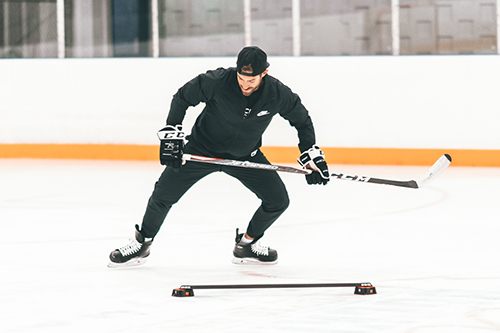
When you are skating on an inside or outside edge your ankle is bearing the weight of your entire body (and sometimes at very extreme angles).
If your ankle doesn’t have the stability and mobility to deal with that, it simply won’t allow you to perform the movement.
And that’s why many hockey players continue to struggle with edge work no matter how much money they fork out for skating lessons.
If you want elite edge work as a hockey player your ankles need to be:
- strong enough to handle heavy loading at high-velocities
- flexible enough to not restrict level changes
- stable enough to keep your balance
- mobile enough to get optimal angles of edge work
And they have to do all of the above while simultaneously being responsive enough to perform all of these tasks as quickly as possible.
We will get further into the mobility side of the equation below when we have a look at some research and then outline a plan of attack for both assessment and application, but right now I want to dive a little deeper into the importance of stability.
The Importance of Ankle Stability in Hockey Performance
Elite hockey athletes must create a stable balance around the ankles because the greater amount of force the ankles can safely absorb and produce results in their ability to transfer into better edge work and overall better skating.
In addition to lower body force production, strengthening the stabilizing muscles around the ankle helps prevent the chronic issues associated with high-velocity motion such as shin splints and tendonitis.
Lastly, and perhaps most importantly, increased ankle stability leads to enhanced proprioception.
Proprioception is the body’s ability to realize its place in space (think of having better “body awareness” out on the ice).
If you’re skating and you’re unable to stabilize the ankle joint structure, the body will send alert signals to the brain warning that the tissue structure is in danger.
You can think about it like how your body warns you before you drop down too low into the splits — it lets you know “Hey! You’re going to get injured if you go further than this.”
Proprioception limits optimal ranges of motion because this safety-measure the body has in place will prevent you from creating deep angles on your inside/outside edges, and thus, reduce your skating potential.
Elite skaters like Crosby don’t have these warning signals in place because their ankle stability can both absorb and redirect very high levels of force, and because of this you regularly see him hit excellent edges on a moment’s notice and slip in and out of mohawk turns like they are nothing.
Ankle stability leads to superior proprioception, and superior proprioception leads to superior balance and awareness during high-speed movement.
Although ankle stability is trained using basic compound movements and plyometrics in the gym, there are muscles whose exclusive function in the body is to stabilize the ankle.
These muscles may not need to be isolated in the average person looking to get healthy, but they are absolutely required to be trained for any hockey player looking to take their skating to the next level.
I’ll show you some of my favorite ankle stability exercises at the bottom of the page, but before we do that we need to discuss the importance of not just stability, but having mobility as well.
How Lack of Ankle Mobility Can Lead To Hockey Injuries
What should hockey athletes do when they want to get strong?
Lift weights of course!
Strength training is a vital component of any complete hockey training program design.
The two biggest compound movements in the game are squat variations and deadlift variations.
Most hockey players never think about their feet during these two movements, yet, I would challenge you that dorsiflexion (think of the shin moving over the top of the foot during a squat) is one of the most critical aspects for maximizing performance in these lifts.
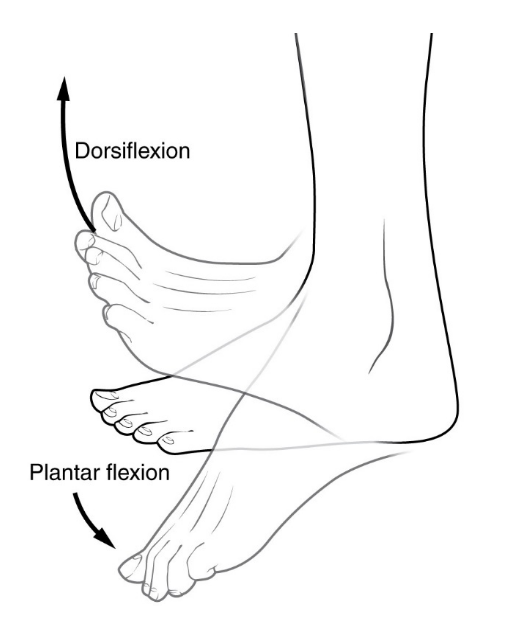
If your ankle isn’t mobile enough during any flexion movement (so, basically all bilateral and unilateral lower body exercises) then your body will always have to find a way to compensate in order to get the range of motion you want out of the exercise.
This compensation typically leads to the heel rising off the ground as they get lower in a squat, or, the knees/feet pronating inwards, which can lead to injuries in hockey players.
Research has demonstrated that a lack of dorsiflexion:
- Is directly correlated to ACL injury risk
- Increases pain in the knees and ankles during activity
- Reduces stability of the ankle joint structure
- Reduces your potential for squat depth
- Helps keep your knees in alignment when performing lower body movements rather than caving inwards
References: 1, 2, 3, 4, and 5 respectively.
Or, to put this another way, ankle mobility is crucially important for health, performance, injury prevention, and to be able to workout without limitations.
Conversely, correcting these mobility issues will allow you to improve your performance on the major compound movements (and feel less pain while doing them) and therefore allow you to become an all-round stronger and more stable hockey player.
I want you to start thinking of your hockey performance machine from the “ground up”.
Start with the feet and work your way upwards from there because if your feet and ankles aren’t doing what you need them to do then you will always have a “ball and chain” holding back your hockey potential.
How Hockey Players Can Test Their Ankle Mobility
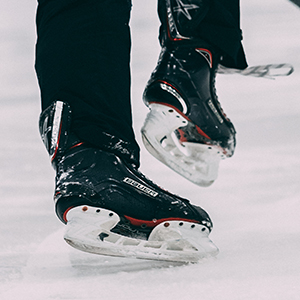
If you have trouble hitting squat depth or if you have hamstring/low back pain during deadlifts than these are two great signs that it’s your ankle mobility that needs the most work.
Hockey players with mobility issues and those with a history of ankle injuries will often struggle with ankle dorsiflexion, but the pain is only sometimes felt at the Achilles tendon.
And often, that tightness will cause pain up to travel up the kinetic chain and into the hamstrings and/or lumbar spine.
Strange enough, you may be able to get your heels decently low at the bottom of a calf raise, leading you to think your ankle mobility is fine.
But, that’s the toes-to-shins mobility.
Your shins-to-toes mobility is a different sequence altogether even though both are classified as forms of dorsiflexion.
The Hockey Training Ankle Mobility Screen
If you think you’re someone who may be suffering from ankle mobility issues then it’s important to first confirm your hypothesis before performing a bunch of exercises that you might not even need.
What you’re going to do is take your shoes off, find a wall, and grab a tape measure.
Once you’ve got all of the above, follow these four steps:
1 – Stand with the big toe of your test foot about 10 cm from a wall, with your foot/toes pointed straight forward at the wall.
2 – Lean your knee straight forward towards with wall without allowing it to move from side-to-side. From here, try to touch your knee to the wall without allowing your heel to lift (this is critical, your heel needs to be planted).
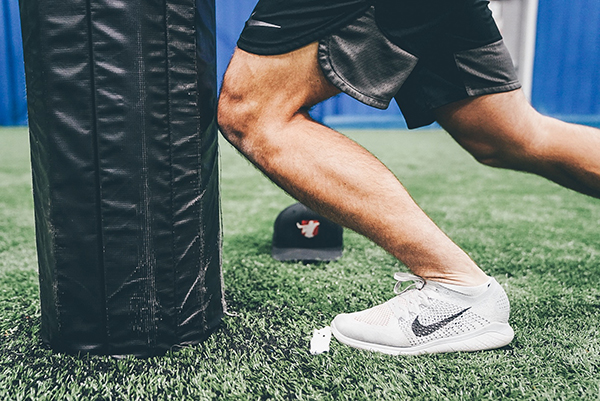
3 – If you can’t get that knee to touch the wall, move forward a bit. If you can, move back a little. Try and find your maximum available range of motion here.
Your test score is based on the greatest distance at which you can touch your knee to the wall without your heel lifting and with your thigh pointed straight at the wall.
4 – Repeat the above three steps with your other foot and compare the two.
A score between 10-12 cm is considered normal and doesn’t represent an ankle that has mobility limitations.
If you fell below 10 cm, your ankle mobility is causing problems from the ground-up and it’s translating into increased injury risk, increased pain in the knees and hips, and a reduced overall hockey performance.
Don’t be too surprised if you failed this test, because you spend so much time in a locked-in skating boot ankle mobility is something that can easily suffer that you will need to progressively keep in check via dryland training and mobility circuits.
Here’s how we can help you become an edge work master by improving your ankle stability and mobility:
Ankle Mobility And Stability Exercises For Hockey Player
Funny enough, the ankle mobility test itself can actually help to improve your mobility as well.
It’s not just a test, it’s an exercise.
Set it up just as I described above and then in a slow and controlled movement, touch your knee to the wall for 2-3 x 10-12 reps per leg.
As your mobility improves, increase the distance slightly over time. This exercise can be performed 1-3x per week depending on your knees.
Additional support exercises that I like to incorporate into my hockey athletes warm-ups, cooldowns, and training to improve ankle mobility and stability include:
Single-Leg Balance And Reach
T-Stands
Toes Elevated Squats
Deep Squat Hold With Toes Elevated
Cossack Squats
Ladder Drill Variations
Hurdle Drill Variations
5-Dot Drill Variations
The Complete Edge Work Solution
The above exercises are great ankle drills to improve your edge work, but if you want a complete solution, the all-new Edge Work Enhancer system was designed to take your edge work to the next level.
This done-for-you edge work system includes 5 variations of hockey-specific edge work training that you can do alongside your current training routine (or use completely on its own) to drastically improve your ankle mobility, stability, and balance so you have the answer to becoming an elite skater.
Remember, if your edge work isn’t great right now, it’s not your fault. This type of training only comes from a hockey performance specialist, and it’s rarely talked about in the hockey world.
Those days are over – get instant access to the Edge Work Enhancer here so you can leave fans, coaches and scouts jaws on the floor with your new stunning edge work.
This is your “overnight success” solution to becoming an elite skater. Click here to get started today!
Article Recap
I hope I was able to articulate the importance of ankle mobility and stability today as it relates to hockey performance potential and reducing injury risk in both your on-ice and off-ice work.
The foot is a part of your body, don’t neglect training it just because it doesn’t have any major muscle groups on it.
Instead, it has a large series of stabilizing muscle groups that work together to allow you to be as balanced and explosive as possible.
Ignoring this aspect of your dryland training is most certainly a sub-optimal program design, especially if you have mobility issues to begin with.
Your edge work depends on it, so let’s get to work. Get started with the Edge Work Enhancer today here!

